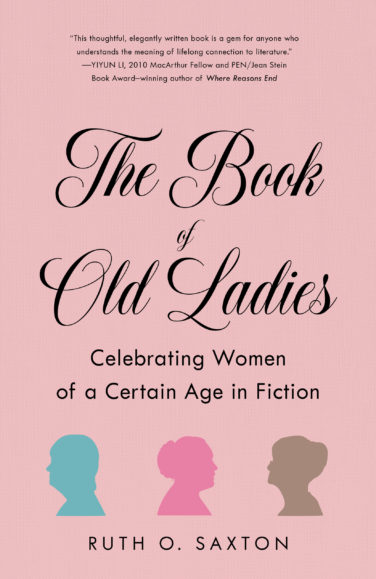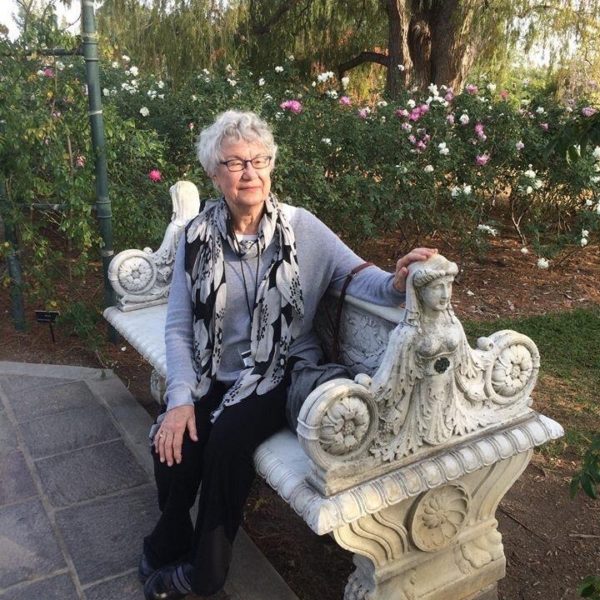Today we have a guest post by Dr. Ruth Saxton. Dr. Saxton is a Professor Emerita of English at Mills College in Oakland, CA. Over the course of her forty-two-year career, she has studied, taught, and published works on fiction by women, focusing on how narratives limit or expand what we imagine to be possible. Dr. Saxton served as the college’s first Dean of Letters and cofounded the Women’s Studies program which is amazing.
The following is an edited excerpt from The Book of Old Ladies: Celebrating Women of a Certain Age in Fiction (She Writes Press, September 2020). In the book, I discuss thirty stories that offer a range of plots for their aging female protagonists, from those that use an older woman’s life in the present as a mere backdrop for the narrative to those in which a woman overcomes difficulties and enjoys the delights age can bring.

Women in the stories I collect seldom have more than two of the three following ingredients in their lives: a satisfying relationship with husband or partner, children, and creative expression or career. Most female protagonists in fiction are either divorced or widowed by the time they are in their sixties. They have chosen artistic or maternal fulfillment, rarely having both. However, in The Love Ceiling (2009), Jean Davies Okimoto’s sixty-four-year-old protagonist, Anne Kuroda Duppstadt, maintains a long marriage, raises two children who continue as adults to enjoy her company, has a beloved three-year-old grandson, and flourishes as an artist late in her life. Okimoto is not the first woman writer to examine the difficult tension for women between family life and creative potential, but her novel is unusual in allowing Annie to achieve satisfaction in her marriage and as a mother and artist.
In The Love Ceiling, set in Seattle in the 2000s, the death of Akiko, Annie’s adored Japanese American mother, leads Annie to pursue a lifelong dream of painting. Her artistic ambition had been stifled by years of being put down by her cruel father, a famous artist who always disparaged her talent, was never challenged by his wife to do otherwise, and continues to make demands of Annie after Akiko’s death. The novel takes its title from Annie’s discovery that when she finally begins to pursue her dream and not settle for her job as craft lady in a senior center, the complications she faces come from the very people she cares about most, leading her to remark, “There is a glass ceiling for women . . . and it’s made out of the people we love.” Okimoto is best known for her many books for children and young adults, and The Love Ceiling reveals her familiar, gentle sense of humor and compassionate insight into the workings of family relationships. Part of the delight of the novel comes from watching Annie increasingly stand up to her family members and define a clear role for herself, particularly when she frees herself from her oppressive relationship with her father.
When she was fifteen, Annie’s art teacher at school had written on the back of her pastel: “You have a gift. An unusual sense of color. An intuitive feeling for light.” But when Annie tentatively approached her father with the pastel after school, he cruelly destroyed it, smearing it with brown paint and gouging it with his palette knife. He announced, “You’ll never be a serious painter.” Annie suppresses her talent and puts her family first until after her mother, shortly before death, apologizes to her for her complicity in indulging Annie’s father, “the great Alexander Gunther,” and allowing him to be the only artist in the house. Her mother elicits a promise from her to move beyond her father’s prohibition and start painting. “You must do it . . . promise me, Annie,” she says. In barely audible words, Akiko whispers, “I’m sorry. I’m sorry about him.” Rather than “too little, too late,” her mother’s remorse was an “unexpected gift.”
Despite the objections of her husband, Jack, Annie begins to study painting with a retired art professor who knew her mother. She spends weeks on her first painting, finishing it in time for her teacher’s exhibition of his students’ work, but her grandson ruins it by spreading dark blue paint over the canvas when Jack fails to keep an eye on him. As she is trying to scrape off the paint and begin again, with the guidance of her teacher, she learns that her father has had a heart attack or a stroke.
Annie feels as if once again Gunther is trying to take her away from her art, but nevertheless she rushes to the hospital, where she learns that he will need extensive rehabilitation. As soon as her father can communicate, he starts making unreasonable demands, but Annie tells him, “Not this time.” Finally, she finds the strength to talk back to him. She promises she will not abandon him, but she also won’t stand his abuse.
Annie’s work in progress, titled “Three Steps Forward, Two Steps Back,” appears in the student exhibition. Vowing never to use her maiden name, she lovingly substitutes her mother’s, and she knows she will always sign her paintings Anne Kuroda Duppstadt. We learn of her later success from the epilogue, which lists Annie’s many art shows and announces that she is still painting in her eighties.
Often authors do not let their protagonists have everything they desire so late in life, perhaps because their own life experience has not allowed for that. But Okimoto allows Annie a full family life and the strength to defy her father and become an artist. Okimoto’s narrative is believable in its portrayal of family life, the power of relationships between children and parents both to harm and to help, and the ways in which even long-married adults can change their established routines and assumptions, take risks, and grow. Annie eventually has it all, and her achievement is not the stuff of fairy tales. Rather, it reinforces our awareness that it’s never too late to confront external impediments and to move beyond internal barriers. Life after sixty can be wonderful and surprising, and coming to age can be profoundly satisfying.
In addition to The Book of Old Ladies, Dr. Saxton’s scholarly works include The Girl: Constructions of the Girl in Contemporary Fiction by Women; Approaches to Teaching Woolf’s Mrs. Dalloway (with Eileen Barrett); and Woolf and Lessing: Breaking the Mold (with Jean Tobin). Find her online at http://ruthsaxton.com/.

